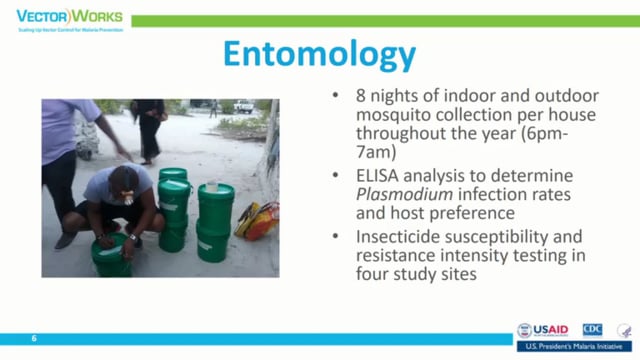Last Updated: 21/05/2019
Ongoing Malaria Transmission: Investigating the Magnitude and Causes of Ongoing Malaria Transmission in Selected Settings
Objectives
The important questions that the research aimed to answer:
- What is the contribution of ongoing transmission to the overall burden?
- What are the causes of ongoing malaria transmission?
To evaluate potential vector control options, it is critical to ascertain whether ongoing malaria transmission arises due to:
- Mosquito resting and feeding behaviour (indoors vs outdoors)
- Feeding preferences (humans, domestic or wild animals)
- Mosquito resting and feeding behaviour (indoors vs. outdoors)
- Interactions with human behaviour (habits, occupations & living places)
These studies will form the baseline scientific evidence for larger projects on more specific topics, including the impact of new vector control tools.
The objectives of the research programme are:
- Produce updated data on the magnitude of ongoing malaria in low- to high-malaria transmission settings.
- Produce scientific evidence of entomological, social and environmental causes of ongoing malaria.
Malaria Consortium, United Kingdom
Cayetano Heredia University (UPCH), Peru
Walter and Eliza Hall Institute of Medical Research (WEHI), Australia
Ifakara Health Institute (IHI), Tanzania
Kenya Medical Research Institute (KEMRI), Kenya
RBM Vector Control Working Group (VCWG), Switzerland
Residual malaria transmission in the Greater Mekong Subregion – Studies to examine its magnitude and identify its causes
Understanding residual transmission for sustainable malaria control and enhancement of elimination efforts in Africa
Understanding human, parasite, vector and environmental interactions driving residual malaria transmission in Papua New Guinea
Residual malaria hotspots in Peru and Brazil: setting the stage for testing improved interventions
Ongoing Malaria Transmission in Tanzania and Burkina Faso: Investigating the magnitude and drivers of persistent malaria
Ongoing malaria transmission is the transmission of malaria that persists even after core malaria measures have been implemented. These measures include: Long-lasting insecticidal nets (LLINs) and Indoor residual spraying (IRS). When implemented well, these interventions are highly effective against susceptible malaria vectors. LLINs and IRS contributed to a 48% reduction in malaria infection prevalence and 47% reduction in mortality worldwide between 2000 and 2013.
Five research projects were selected and supported to provide the baseline evidence of ongoing malaria in selected settings.


